wheel Lexus IS250 2006 Using the audio system / LEXUS 2006 IS350/250 THROUGH APRIL 2006 PROD. (OM53508U) Workshop Manual
[x] Cancel search | Manufacturer: LEXUS, Model Year: 2006, Model line: IS250, Model: Lexus IS250 2006Pages: 433, PDF Size: 10.9 MB
Page 345 of 433
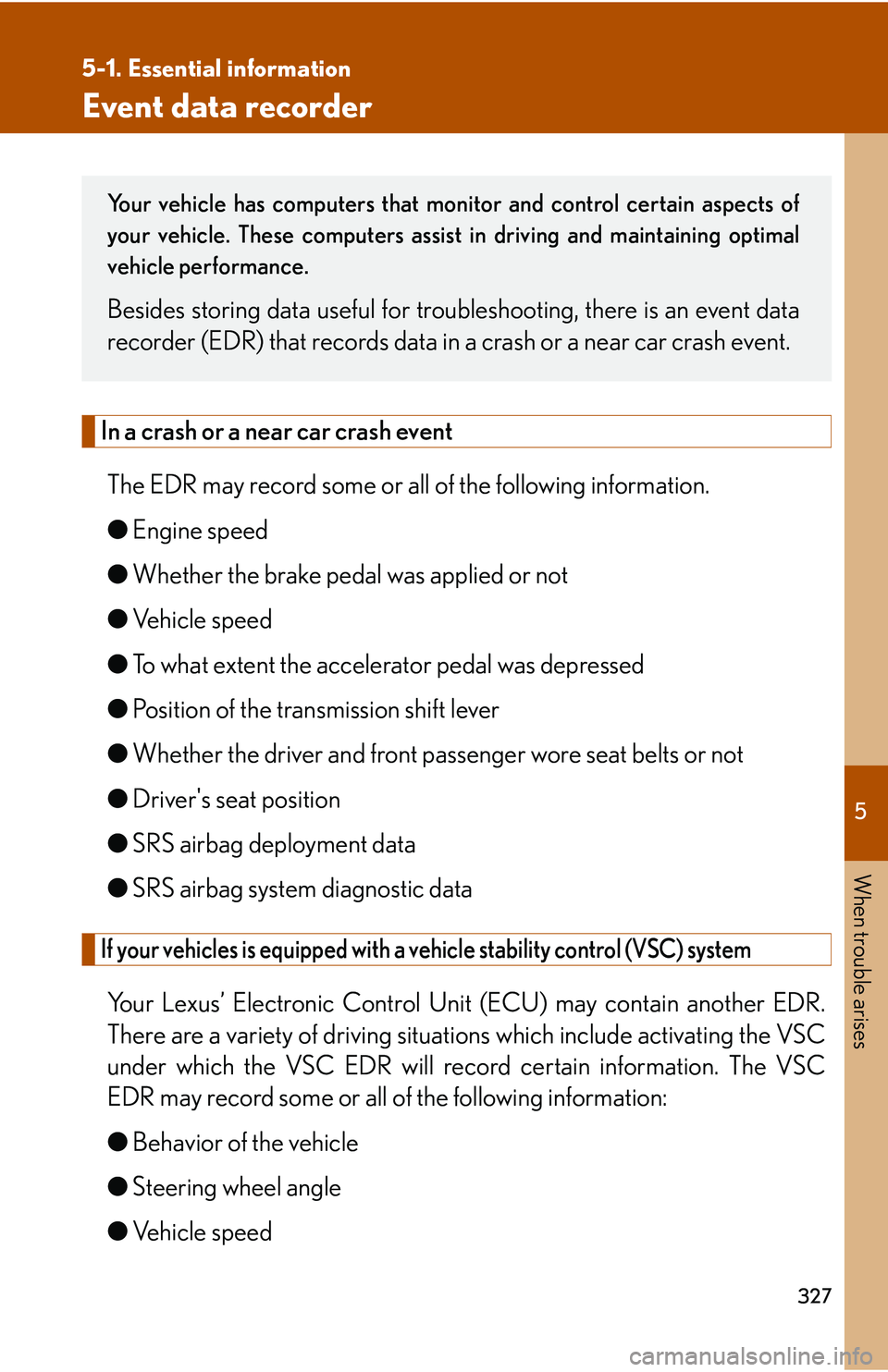
5
When trouble arises
327
5-1. Essential information
Event data recorder
In a crash or a near car crash eventThe EDR may record some or all of the following information.
● Engine speed
● Whether the brake pedal was applied or not
● Vehicle speed
● To what extent the accelerator pedal was depressed
● Position of the transmission shift lever
● Whether the driver and front passenger wore seat belts or not
● Driver's seat position
● SRS airbag deployment data
● SRS airbag system diagnostic data
If your vehicles is equipped with a vehicle stability control (VSC) system
Your Lexus’ Electronic Control U nit (ECU) may contain another EDR.
There are a variety of driving situati ons which include activating the VSC
under which the VSC EDR will reco rd certain information. The VSC
EDR may record some or all of the following information:
● Behavior of the vehicle
● Steering wheel angle
● Vehicle speed
Your vehicle has computers that monitor and control certain aspects of
your vehicle. These computers assist in driving and maintaining optimal
vehicle performance.
Besides storing data usef ul for troubleshooting, there is an event data
recorder (EDR) that records data in a crash or a near car crash event.
Page 346 of 433
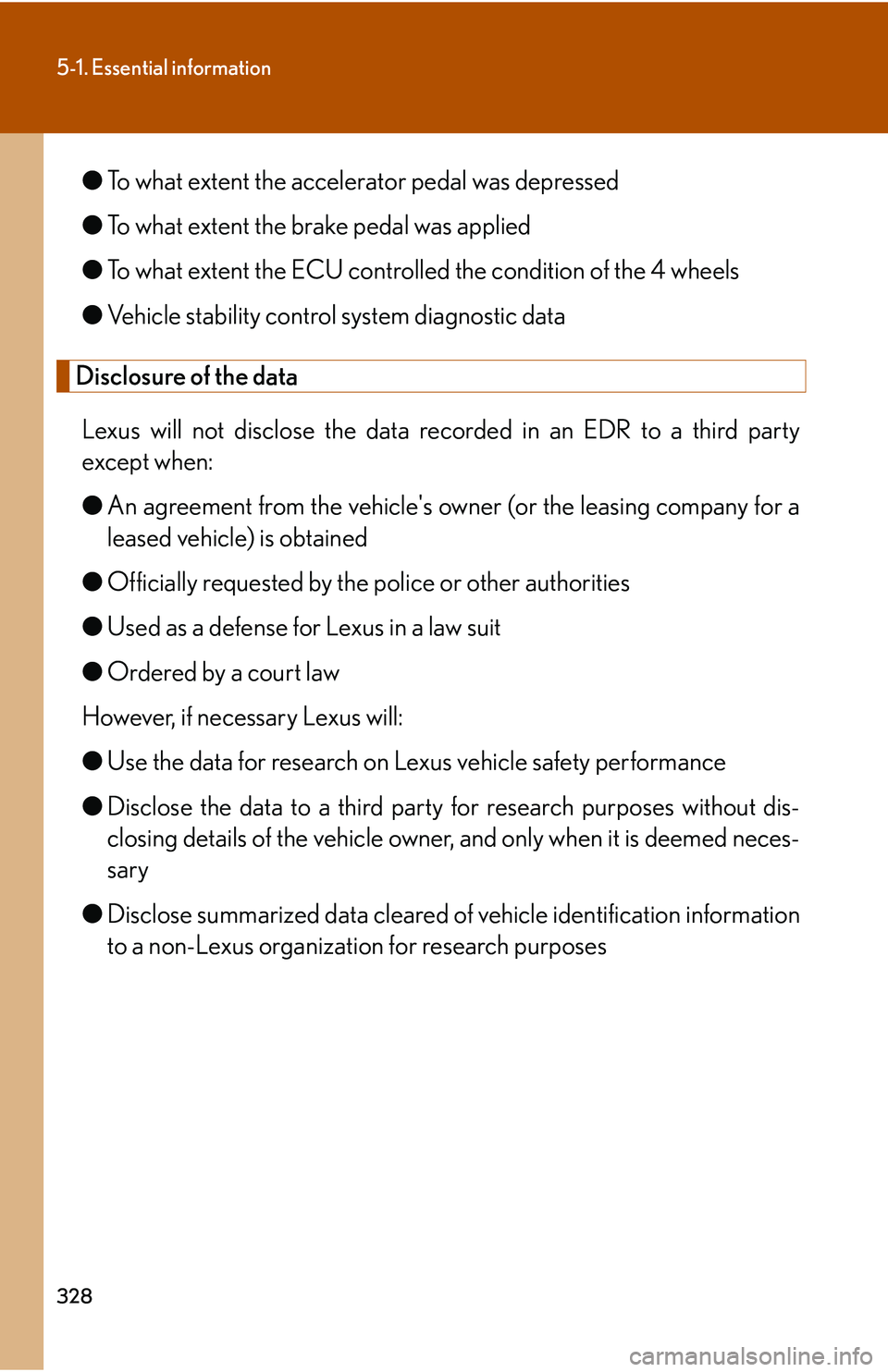
328
5-1. Essential information
●To what extent the accelerator pedal was depressed
● To what extent the brake pedal was applied
● To what extent the ECU controlled the condition of the 4 wheels
● Vehicle stability control system diagnostic data
Disclosure of the data
Lexus will not disclose the data re corded in an EDR to a third party
except when:
● An agreement from the vehicle's ow ner (or the leasing company for a
leased vehicle) is obtained
● Officially requested by the police or other authorities
● Used as a defense for Lexus in a law suit
● Ordered by a court law
However, if necessary Lexus will:
● Use the data for research on Le xus vehicle safety performance
● Disclose the data to a third party for research purposes without dis-
closing details of the vehicle owner, and only when it is deemed neces-
sary
● Disclose summarized data cleared of vehicle identification information
to a non-Lexus organization for research purposes
Page 355 of 433
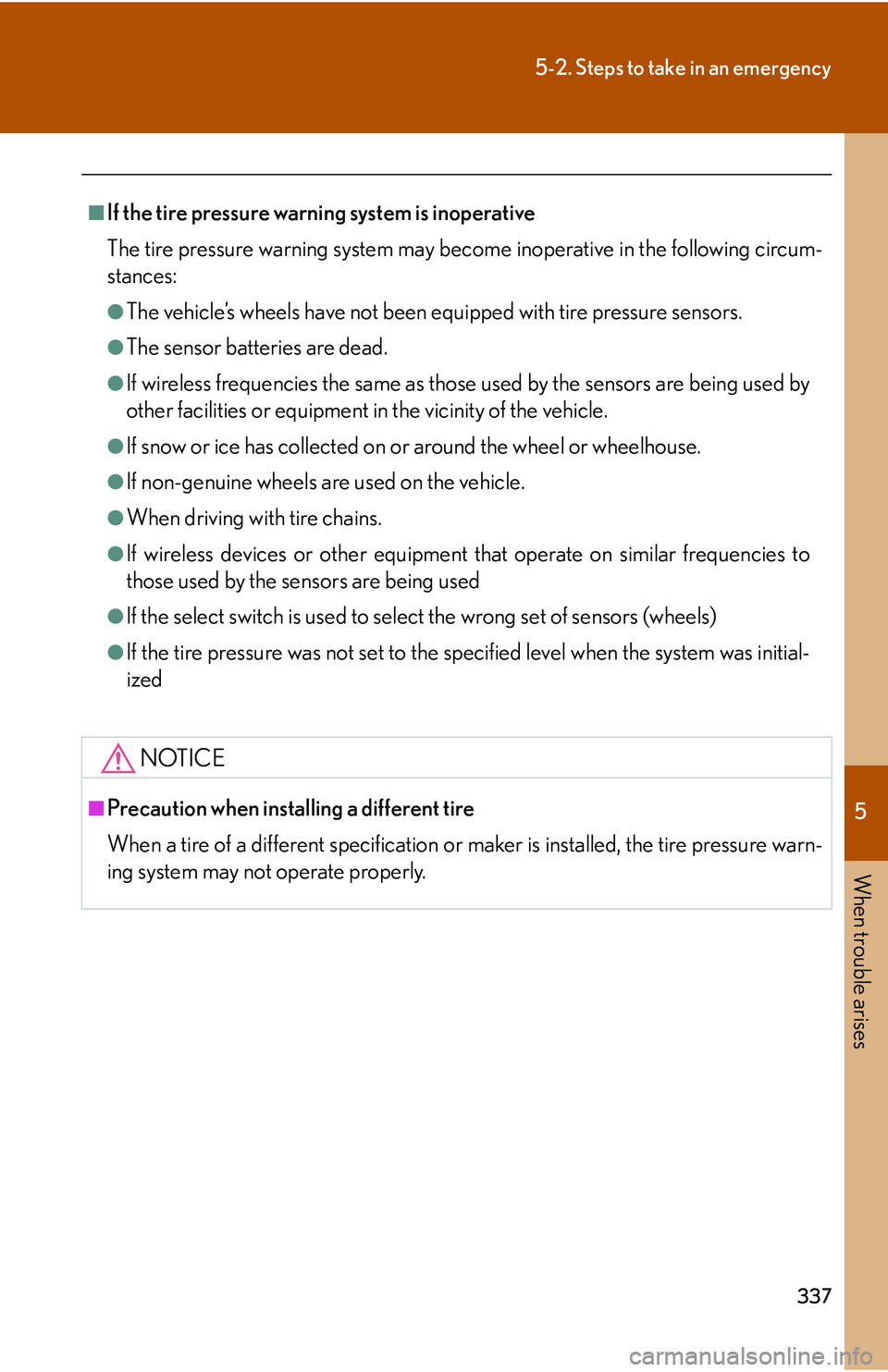
5
When trouble arises
337
5-2. Steps to take in an emergency
■If the tire pressure warning system is inoperative
The tire pressure warning system may become inoperative in the following circum-
stances:
●The vehicle’s wheels have not been equipped with tire pressure sensors.
●The sensor batteries are dead.
●If wireless frequencies the same as those used by the sensors are being used by
other facilities or equipment in the vicinity of the vehicle.
●If snow or ice has collected on or around the wheel or wheelhouse.
●If non-genuine wheels are used on the vehicle.
●When driving with tire chains.
●If wireless devices or other equipment that operate on similar frequencies to
those used by the sensors are being used
●If the select switch is used to select the wrong set of sensors (wheels)
●If the tire pressure was not set to the specified level when the system was initial-
ized
NOTICE
■Precaution when insta lling a different tire
When a tire of a different specification or maker is installed, the tire pressure warn-
ing system may not operate properly.
Page 365 of 433

5
When trouble arises
347
5-2. Steps to take in an emergency
InteriorbuzzerExterior buzzerWa r n i n g m e s s a g eDetailsCorrection
procedure
Once
(For vehicles with an
automatic transmission)
Indicates that a
door has been
opened or closed
and the engine
switch has been
switched twice to
ACC mode from
OFF.
Press the engine
switch while
applying the
brakes.
Once
(For vehicles with a
manual transmission)
Indicates that a
door has been
opened or closed
and the engine
switch has been
switched twice to
ACC mode from
OFF.
Press the engine
switch while
depressing the
clutch pedal.
Once
(Flashing)
Indicates that the
steering lock has
not released
within 3 seconds
of pressing the
engine switch.Press the engine
switch again while
turning the steer-
ing wheel with the
brake pedal
depressed.
Page 368 of 433

350
5-2. Steps to take in an emergency
Replacing a flat tireChock the tires.
Slightly loosen the wheel nuts (one
turn).
Turn the tire jack portion “A” by
hand until the notch of the jack is in
contact with the jack point.
STEP1
Flat tireWheel chock positions
Front
Left-hand
sideBehind the
rear right-
hand side tire
Right-
hand sideBehind the
rear left-
hand side tire
Rear
Left-hand
sideIn front of the
front right-
hand side tire
Right-
hand sideIn front of the
front left-
hand side tire
STEP2
STEP3
Page 369 of 433
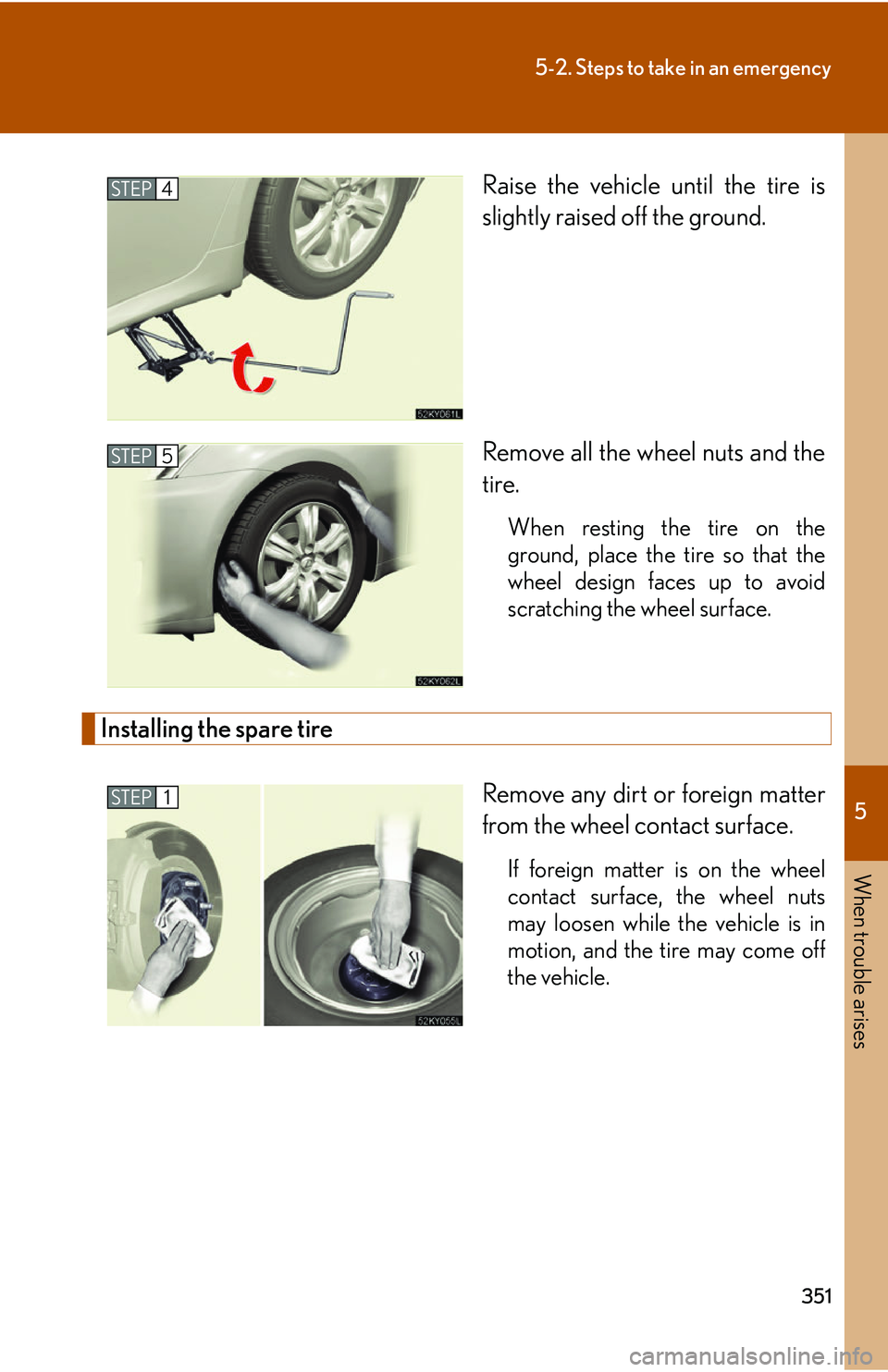
5
When trouble arises
351
5-2. Steps to take in an emergency
Raise the vehicle until the tire is
slightly raised off the ground.
Remove all the wheel nuts and the
tire.
When resting the tire on the
ground, place the tire so that the
wheel design faces up to avoid
scratching the wheel surface.
Installing the spare tireRemove any dirt or foreign matter
from the wheel contact surface.
If foreign matter is on the wheel
contact surface, the wheel nuts
may loosen while the vehicle is in
motion, and the tire may come off
the vehicle.
STEP4
STEP5
STEP1
Page 370 of 433
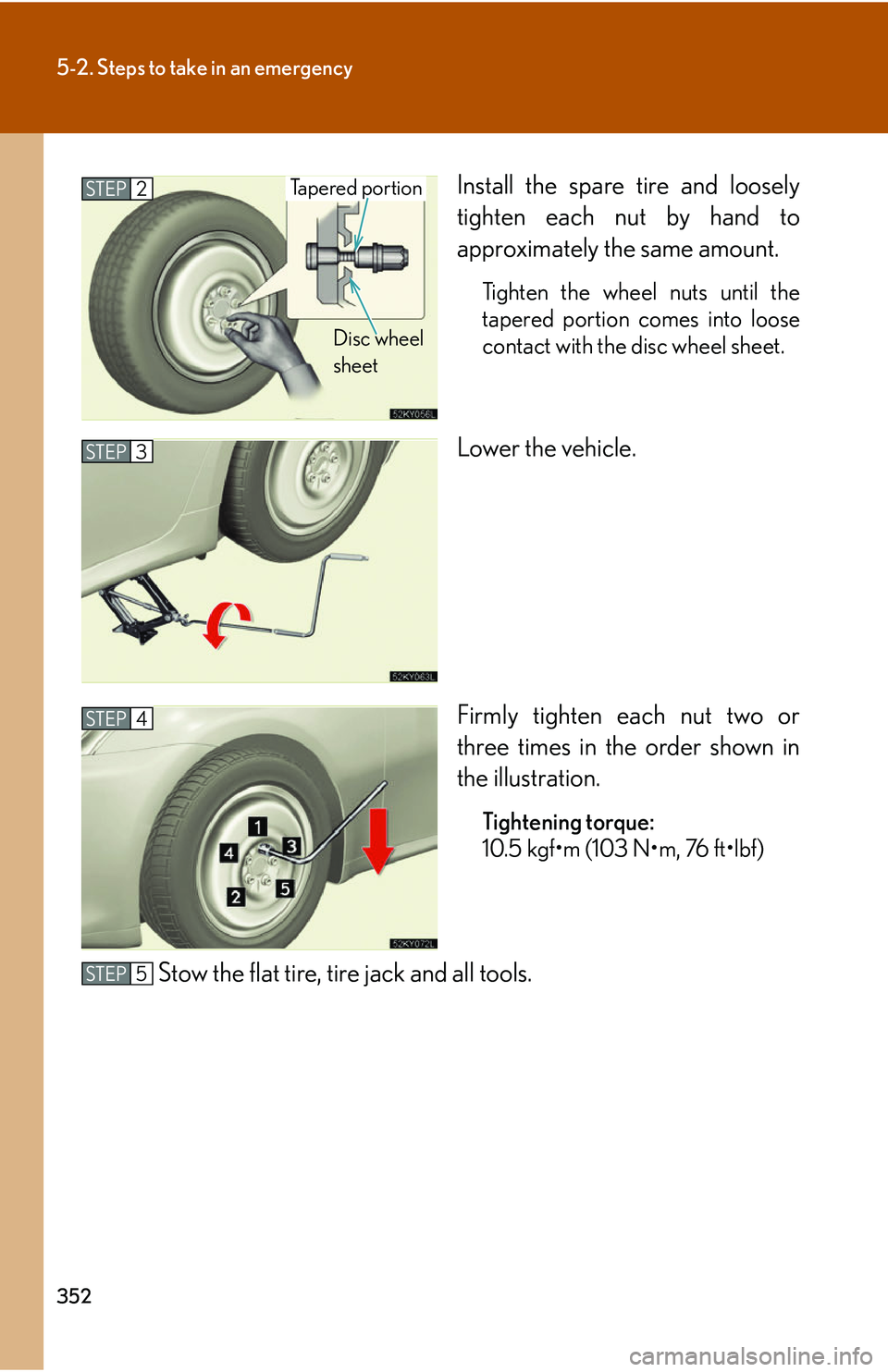
352
5-2. Steps to take in an emergency
Install the spare tire and loosely
tighten each nut by hand to
approximately the same amount.
Tighten the wheel nuts until the
tapered portion comes into loose
contact with the disc wheel sheet.
Lower the vehicle.
Firmly tighten each nut two or
three times in the order shown in
the illustration.
Tightening torque:
10.5 kgf•m (103 N•m, 76 ft•lbf)
Stow the flat tire, tire jack and all tools.
STEP2
Disc wheel
sheet
Tapered portion
STEP3
STEP4
STEP5
Page 372 of 433
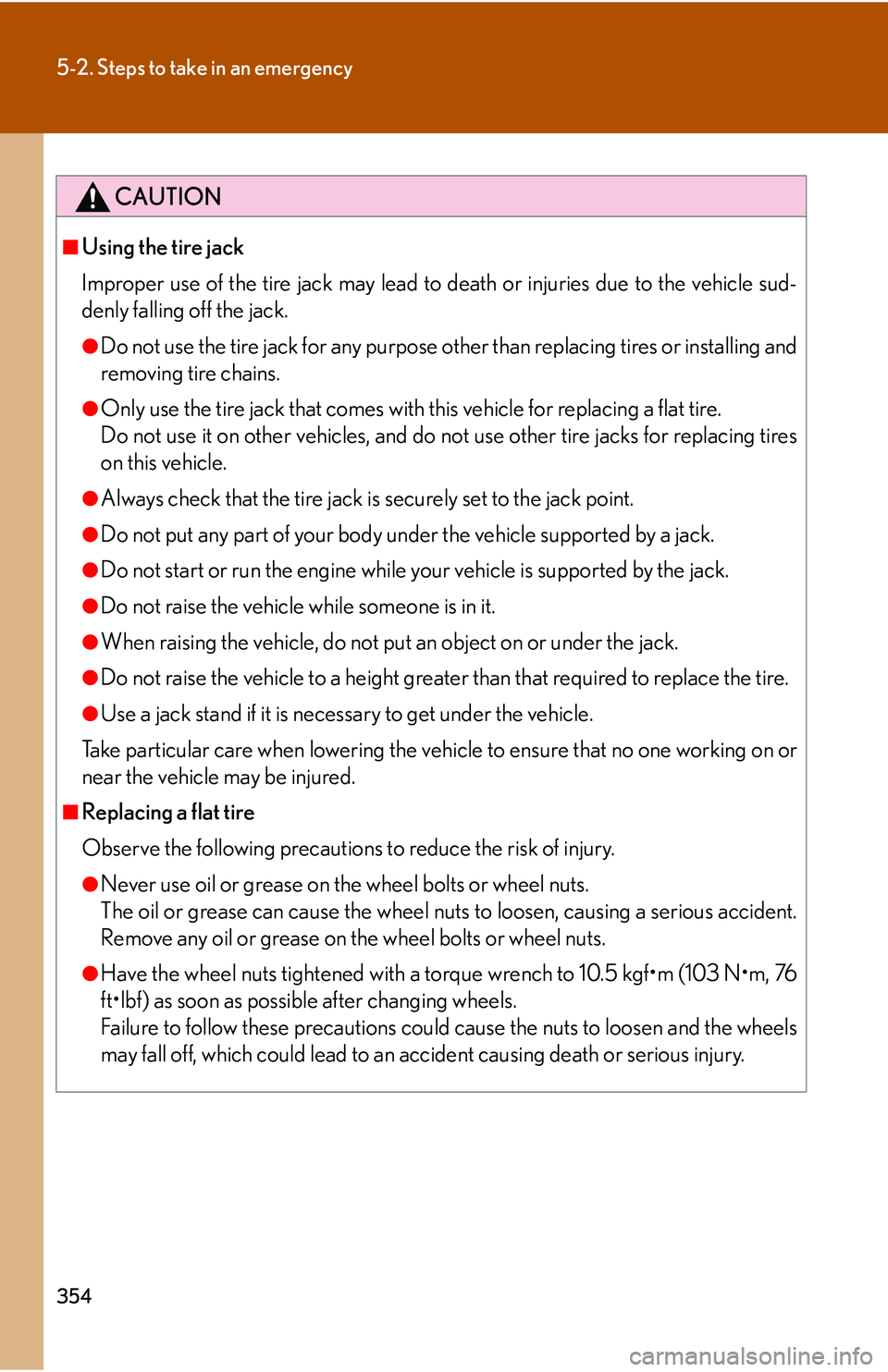
354
5-2. Steps to take in an emergency
CAUTION
■Using the tire jack
Improper use of the tire jack may lead to death or injuries due to the vehicle sud-
denly falling off the jack.
●Do not use the tire jack for any purpose other than replacing tires or installing and
removing tire chains.
●Only use the tire jack that comes with this vehicle for replacing a flat tire.
Do not use it on other vehicles, and do not use other tire jacks for replacing tires
on this vehicle.
●Always check that the tire jack is securely set to the jack point.
●Do not put any part of your body under the vehicle supported by a jack.
●Do not start or run the engine while your vehicle is supported by the jack.
●Do not raise the vehicle while someone is in it.
●When raising the vehicle, do not put an object on or under the jack.
●Do not raise the vehicle to a height greate r than that required to replace the tire.
●Use a jack stand if it is necessary to get under the vehicle.
Take particular care when lowering the vehicle to ensure that no one working on or
near the vehicle may be injured.
■Replacing a flat tire
Observe the following precautions to reduce the risk of injury.
●Never use oil or grease on the wheel bolts or wheel nuts.
The oil or grease can cause the wheel nuts to loosen, causing a serious accident.
Remove any oil or grease on the wheel bolts or wheel nuts.
●Have the wheel nuts tightened with a torq ue wrench to 10.5 kgf•m (103 N•m, 76
ft•lbf) as soon as possible after changing wheels.
Failure to follow these precautions could cause the nuts to loosen and the wheels
may fall off, which could lead to an accident causing death or serious injury.
Page 373 of 433
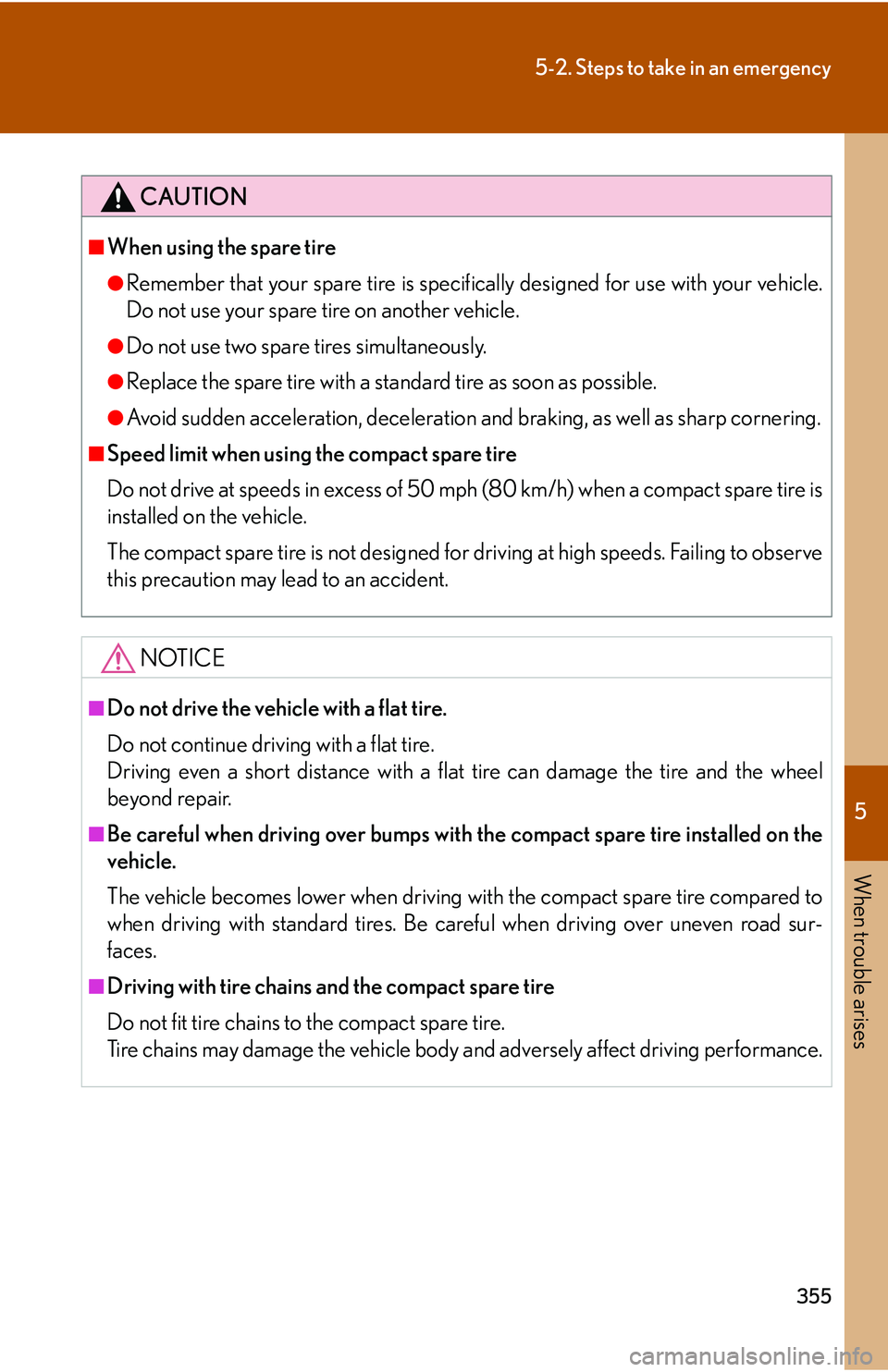
5
When trouble arises
355
5-2. Steps to take in an emergency
CAUTION
■When using the spare tire
●Remember that your spare tire is specifically designed for use with your vehicle.
Do not use your spare tire on another vehicle.
●Do not use two spare tires simultaneously.
●Replace the spare tire with a standard tire as soon as possible.
●Avoid sudden acceleration, deceleration and braking, as well as sharp cornering.
■Speed limit when using the compact spare tire
Do not drive at speeds in excess of 50 mph (80 km/h) when a compact spare tire is
installed on the vehicle.
The compact spare tire is not designed for driving at high speeds. Failing to observe
this precaution may lead to an accident.
NOTICE
■Do not drive the vehicle with a flat tire.
Do not continue driving with a flat tire.
Driving even a short distance with a flat tire can damage the tire and the wheel
beyond repair.
■Be careful when driving over bumps with the compact spare tire installed on the
vehicle.
The vehicle becomes lower when driving with the compact spare tire compared to
when driving with standard tires. Be careful when driving over uneven road sur-
faces.
■Driving with tire chains and the compact spare tire
Do not fit tire chains to the compact spare tire.
Tire chains may damage the vehicle body and adversely affect driving performance.
Page 385 of 433

5
When trouble arises
367
5-2. Steps to take in an emergency
If the vehicle becomes stuck
CAUTION
■When attempting to free a stuck vehicle
If you choose to rock the vehicle back and forth to free it, make sure the surround-
ing area is clear, to avoid striking other vehicles, objects or persons. The vehicle
may also lunge forward or lunge back suddenly as it becomes free. Use extreme
caution.
■When shifting the shift lever
With automatic transmission vehicles, be careful not to shift the shift lever with the
accelerator pedal depressed.
This may lead to unexpected rapid acceleration of the vehicle that may cause an
accident and result in death or serious injury.
NOTICE
■To avoid damaging the transmission and other components
●Avoid spinning the wheels and do not rev the engine.
●If the vehicle remains stuck after trying these procedures, the vehicle may require
towing to be freed.
Carry out the following procedures if the tires spin or the vehicle becomes
stuck in mud, dirt, or snow.
● Stop the engine. Set th e parking brake and put the selector lever
in P (vehicles with an automatic transmission) or N (vehicles with
a manual transmission).
● Remove the mud, snow, or sand from around the stuck tire.
● Place wood, stones or some other material to help provide trac-
tion under the tires.
● Restart the engine.
● For 2WD vehicles only: Turn the traction control OFF. ( P. 141)
● Carefully apply the accelerator to free the vehicle.